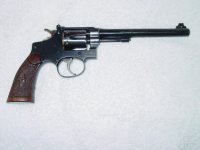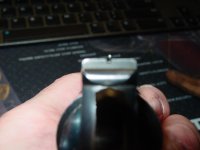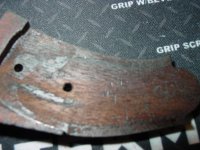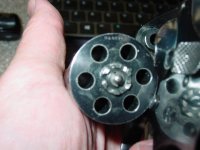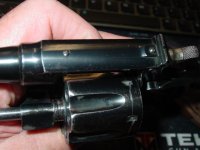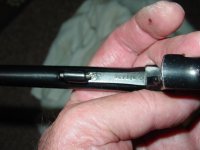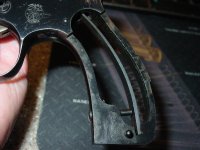I purchased this .22/32 HFT yesterday, spent 8 hours taking it apart enough to thoroughly clean & lubricate it, and verify serial and assembly numbers. It was nasty, except for minor hard grease and oil/powder gunk under the side plate. The cylinder would barely rotate. I will sight it in today, but would like to know as much as I can about it. Seller believes it is a Bekeart model?
What I Do Know:
Serial #364306 appears on the Front Strap, Cylinder Face, Under the Extractor star, Under the Barrel at the bore area and on the Right Grip inside surface in what looks to be faint grease or pencil, hard to see unless under magnification or in poor lighting.
Assembly Number 5353 appears on the Yoke and Frame Support for the Yoke, and in the groove milled on the inner flat of the side plate.
Blue 6" barrel appears to have a replacement Paine bead Front Sight, poorly installed by Mr. Ham Fist.
Rear Sight is adjustable with U-Notch blade.
Rear Sight is a wonderful piece of fine-tolerance milling work, fully functional. Hardest part with these guns is finding the proper size screwdrivers for the extremely tiny slots in the small sight screws.
Trademark is small version below the thumb latch.
USA stamp is not evident on either side of the frame.
Patent Date June 5, 1917 on bottom of Left stock.
Back-strap is of Rebated style.
Stocks have Diamonds and checkering, but no emblems.
S/A Trigger pull is crisp @ 3.6#
D/A Trigger is long and consistent, but heavy @10# plus.
I took pictures when I had it apart for cleaning, as good as my old Sony digital could take, anyway. Gun's previous owner(s) were ham-handed with pin punches at the front sight and at the Firing Pin retaining pin, but the screws were unmolested and from the wear on the stocks, the gun was much-used and while dirty from use, has very minor rust splotches with some holster wear.
I'll post some 25 yard Bullseye targets after I use up the last of my Tenex and some SK+ today.
Any info regarding this pistol would be appreciated. The history of these old revolvers is almost as entertaining as shooting them.
Anyone know where I can get a set of target or combat grips to fit this frame size? I already tried out every K-frame grip I have, no joy of course. If I have to go custom, I will if I can find someone to make set. My hands are way too big for this frame size. It isn't much larger than my Top-Break 4th gen .38. And the folks in the 20's thought these guns were big?
Thanks for everyone's help getting info on this and my other antiquities!
Arman
What I Do Know:
Serial #364306 appears on the Front Strap, Cylinder Face, Under the Extractor star, Under the Barrel at the bore area and on the Right Grip inside surface in what looks to be faint grease or pencil, hard to see unless under magnification or in poor lighting.
Assembly Number 5353 appears on the Yoke and Frame Support for the Yoke, and in the groove milled on the inner flat of the side plate.
Blue 6" barrel appears to have a replacement Paine bead Front Sight, poorly installed by Mr. Ham Fist.
Rear Sight is adjustable with U-Notch blade.
Rear Sight is a wonderful piece of fine-tolerance milling work, fully functional. Hardest part with these guns is finding the proper size screwdrivers for the extremely tiny slots in the small sight screws.
Trademark is small version below the thumb latch.
USA stamp is not evident on either side of the frame.
Patent Date June 5, 1917 on bottom of Left stock.
Back-strap is of Rebated style.
Stocks have Diamonds and checkering, but no emblems.
S/A Trigger pull is crisp @ 3.6#
D/A Trigger is long and consistent, but heavy @10# plus.
I took pictures when I had it apart for cleaning, as good as my old Sony digital could take, anyway. Gun's previous owner(s) were ham-handed with pin punches at the front sight and at the Firing Pin retaining pin, but the screws were unmolested and from the wear on the stocks, the gun was much-used and while dirty from use, has very minor rust splotches with some holster wear.
I'll post some 25 yard Bullseye targets after I use up the last of my Tenex and some SK+ today.
Any info regarding this pistol would be appreciated. The history of these old revolvers is almost as entertaining as shooting them.
Anyone know where I can get a set of target or combat grips to fit this frame size? I already tried out every K-frame grip I have, no joy of course. If I have to go custom, I will if I can find someone to make set. My hands are way too big for this frame size. It isn't much larger than my Top-Break 4th gen .38. And the folks in the 20's thought these guns were big?
Thanks for everyone's help getting info on this and my other antiquities!
Arman

